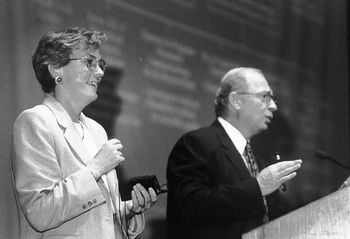Institution's performance outlined

Dr. Harry Jacobson and Lee Limbird, Ph.D., reviewed the medical center's performance during the past year at last week's Spring Faculty Meeting. (Photo by Donna Jones Bailey)
If the information presented at last week's Spring Faculty Meeting is any indication, Vanderbilt University Medical Center is making strides toward achieving the stated goal of becoming a top-10 academic health center.
Key indicators ‹ such as revenues, admissions to Vanderbilt University Hospital, outpatient visits to The Vanderbilt Clinic, emergency room visits, average length of patient stays, average charges and the institution's share of federal research dollars ‹ are all extremely positive, reflecting the hard work done in recent years to streamline the institution's procedures.
"We are on the right track and doing the things we need to do to become one of the country's top academic medical centers," said Dr. Harry R. Jacobson, Vice Chancellor for Health Affairs. "At the same time, there are still a number of challenges ahead of us ‹ challenges that can become opportunities."
Before a Langford auditorium crowd of faculty members, Jacobson recapped the institution's performance during fiscal year 1998, which concludes at the end of this month.
It is forecasted that VUMC will record gross revenues of $617,168,000 for the fiscal year, net revenues of $415,956,000 and expenses of $401,097,000, leaving $14,859,000 available for capital and program support for research and education.
"This is money that can be used for capital improvements and program support, such as additional faculty and necessary equipment," Jacobson said.
Many individual areas of the medical center have met or exceeded projections. After dipping slightly the past two years, hospital admissions will rise 6.3 percent to 30,300. Outpatient visits to The Vanderbilt Clinic have grown dramatically during the past year, and should rise 9.8 percent to 519,500 ‹ an increase of 46,000 visits.
Emergency room visits will continue their steady upward march, rising 3 percent to 47,000. Operating room procedures will be about 21,200, up 7.6 percent from last year's 19,700.
In addition to this operational growth, VUMC has continued its quest to streamline procedures. Compared with the other health care providers in the Middle Tennessee market, VUMC's clinically adjusted average charges as a percentage of the market are anticipated to be 101 percent this year. Six years ago, that figure stood at a whopping 124 percent.
Likewise, patients' length of stay during that same time period have been reduced from seven days to 5.4 days.
One thing that has changed little during the past few years is the makeup of the hospital and clinic's payor mix. Last year the hospital and clinic received its revenues from Medicare (21.7 percent), Blue Cross (12.4 percent), TennCare (23.7 percent) and all others, including private and employer insurance (42.2 percent).
Tennessee's move to TennCare four years ago, however, is continuing to squeeze VUMC's ability to fund patient care services and to provide the needed support for the institution's other missions of research and education. In each of the last three years, VUMC has lost more than $16 million per year in providing care to the state's neediest citizens in essential services like the trauma center, the Neonatal Intensive Care Unit, LifeFlight and the burn center.
During fiscal year 1998, VUMC committed $64.9 million in capital improvements to the VUMC campus, including numerous building renovations, patient care equipment and new programs.
Looking ahead to fiscal year 1999, institution leadership is forecasting $9.9 million to be available for capital improvements and program support on net revenues expected to rise 8.5 percent to $451.7 million.
Several aspects of VUMC's clinical enterprise have been targeted as priorities for the coming year, including:
o Continued cost reduction and control;
o VMG organization;
o VUH patient care centers;
o Information systems, including Year 2000 compliance, support for analysis of profitability and quality, and expansion of Management Information System capacity and reliability;
o Completion of the Vanderbilt Heart Institute;
o Development of joint ventures with hospitals outside of Davidson County;
o Development of a Geriatrics program.
Jacobson also outlined several challenges facing VUMC over the next few years, challenges that must be transformed into opportunities if the institution is to become one of the nation's top-tier academic health care centers. These include:
o To succeed as a full-service provider of health care;
o To continue providing Middle Tennesseeans with essential services while minimizing the associated operating losses, such as TennCare;
o To take fullest advantage of increased funding for biomedical research, including expanding the research faculty;
o To grow technology transfer and its resultant new business development.
It's this last area, research and technology transfer, that holds the greatest promise for VUMC to improve not only its national standing, but also its financial strength, which will result in more education opportunities and greater benefit for patients, Jacobson said.
"While the majority of revenues and expenses are focused on patient care, our major opportunities lie in research and technology transfer," Jacobson said. "If our assumptions and projections hold, we will be well positioned as long as we continue to execute our strategic plan."













